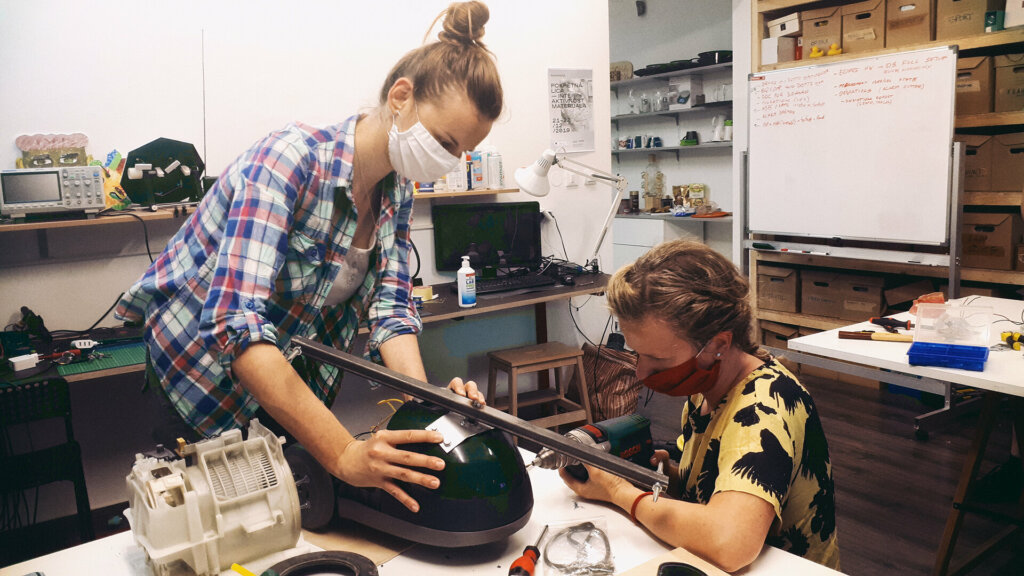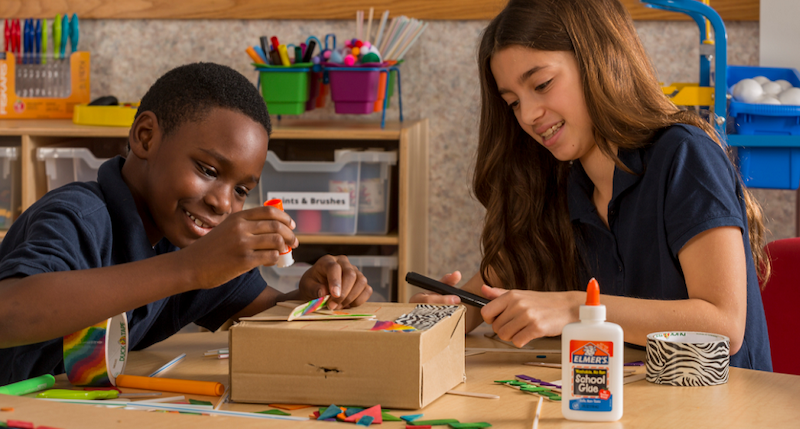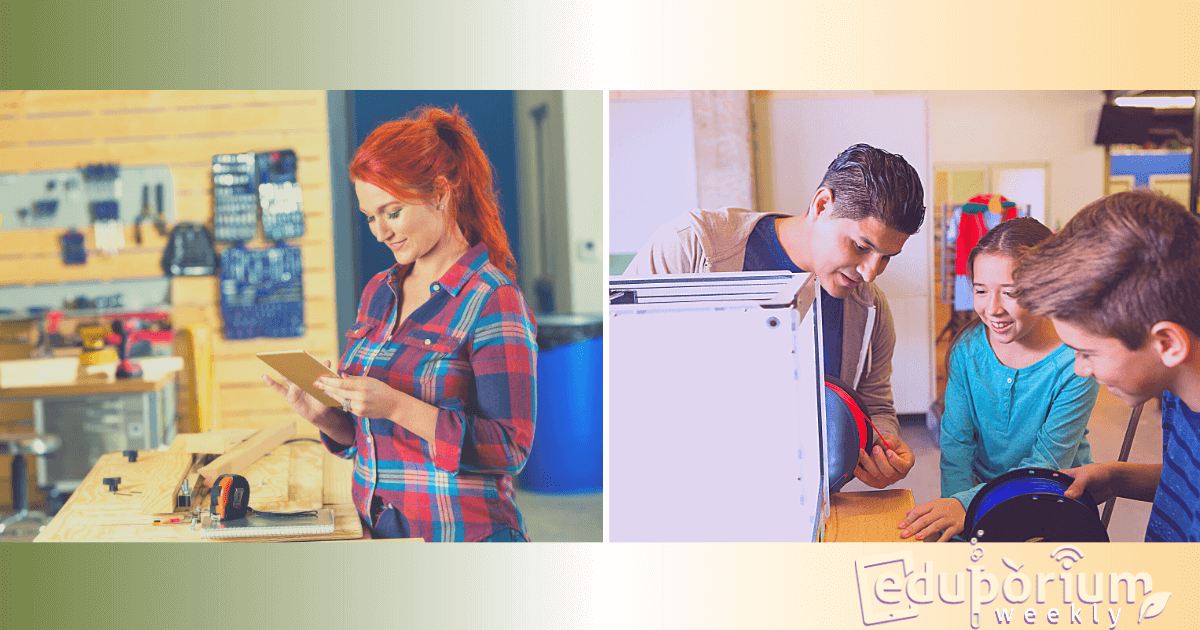A school makerspace is often only as effective as the tools that children can access and create with when designing, building, or exploring inventiveness in learning. And, since there aren't many requirements for what makerspaces should include, there are so many options for innovation. Every makerspace is different but, if you're looking for hands-on tech and non-tech tools for yours, we have some suggestions. So, here are some of our favorites for all areas of STEAM learning and collaborative exploration in a maker setting.
Whether you are looking to start small or make your space robust, many STEAM and EdTech tools work in various situations. We know that some of the best school makerspaces are informal with students simply using everyday items, like cardboard, scissors, and tape. And, we understand that, if that works best given your resources, then that is totally fine. There are certainly plenty of positives about this type of exploratory learning, like kids developing resourcefulness, creative thinking, and persistence. Though we offer more of the technology-based makerspace materials as opposed to your craft supplies, however, we can certainly still help educators take their makerspaces to the next level.
Digital fabrication tools in the school makerspace.
One of the most consistent and real-world elements of school and library makerspaces is some presence of digital fabrication. Typically, this might involve 3D printers or CNC machines—or one of each depending on affordability, student interests, and space. As for 3D creation, we carry some of the best 3D printers for education, including the MakerBot, LulzBot, and FlashForge lines, and even the complete 3Doodler 3D pen line as well. Plus, in many cases, educators can also purchase these printers, filaments, accessories, and curriculum together in 3D printer bundles.

While 3D printers enable students to explore additive manufacturing, CNC machines permit the opposite. Kids can use these tools to perform subtractive manufacturing—taking a piece of material then sculpting it into something useful. In terms of CNC machines, there are actually plenty of reliable ones for a technology or makerspace curriculum but there are other digital creation tools beyond just the 3D printers and CNC machines, too. One of the most popular options in addition to those types of STEM products are 3D laser printers. And, as you might know, one of the biggest names in STEM and maker education is Glowforge.
With the line of powerful, simple, and compact 3D laser printers, the Glowforge machines help students turn digital designs into physical objects. They also fit easily into classrooms, libraries, or makerspaces and align with high school STEAM lessons and students' skill levels. Whether using the Glowforge Plus or the Glowforge Pro, students can choose from dozens of different materials to design anything from trinkets to sculptures and engrave them for even more customization. If interested, we'd recommend researching the long list of compatible Glowforge materials and how students can use them in makerspaces.
Circuitry kits for students.
Another key piece when creating engaging and effective makerspaces is including tools that help illustrate circuitry concepts. The great thing about exploring circuitry is that students of any age can use the different kits to build lots of intriguing projects that highlight its most important concepts. And, many of these STEM kits also include bins or storage components to improve organization in your maker environment. First and foremost, when we think of circuitry, it often involves students combining engineering and design thinking with physical construction. Sometimes, they might be able to program the devices they construct using a school circuitry kit after completing the build, too.
Some of the most popular circuitry kits for makerspaces, especially across K-12 education, are the Snap Circuits solutions. Using these STEAM products, students can construct hundreds of electronics projects simply by following the detailed and simplistic project guides. Another option when introducing circuitry in makerspace learning is the E-Blox product line. Perfect for your elementary school makerspaces, these snap-together blocks are electronic, meaning kids assemble structures that actual electricity flows through. They're completely safe to use and even teach kids about how to avoid creating short circuits. With various E-Blox kits to choose from, teachers could implement makerspace lessons about engineering and circuitry and encourage student collaboration.

The last circuitry item we’ll recommend for makerspaces is the Squishy Circuits line. These STEAM kits feature conductive Play-Doh that kids in the K-3 range can use for learning about conductivity, complete circuits, and sculpt inventive artwork. They also include project guides but the kits are just as useful when kids design sculptures on their own. Among other possibilities, students can use the conductive dough to sound buzzers, illuminate LEDs, and power a fan.
Teaching with educational robotics tools in a makerspace.
Finally, no makerspace environment is complete without a little bit of robotics and coding. As we know, coding is a crucial 21st century skill and makerspace experiences can help students to perfect their craft. Plus, there are some robots for education that students can build, which helps capture the spirit of the Maker Movement. At the top of this list are the Cubelets Robots. These kits are available in all different sizes and are perfect for engaging students in meaningful MakerEd projects. Students can construct the robots and program them using block coding or text coding. And, they can learn about various avenues for using robotics systems since the Cubelets blocks each have a specific function.
Additional robotics options for teaching programming while you also incorporate MakerEd include teacher favorites, like the versatile Hummingbird Bit, Ozobot Evo, Dash Robot, mBot Robot, Edison Robot with the EdSketch attachment, Cubetto Robot, and the UKITs from UBTECH Education among others. Each of these helps get students working with their hands and inventing new opportunties to learn. To check out all of the robotics tools we offer, visit our store. And, if you'd want some consultation regarding setting up a makerspace in your school or library, please feel free to contact our team or check out our white paper on library makerspaces! Follow us on Twitter and Instagram for more.



